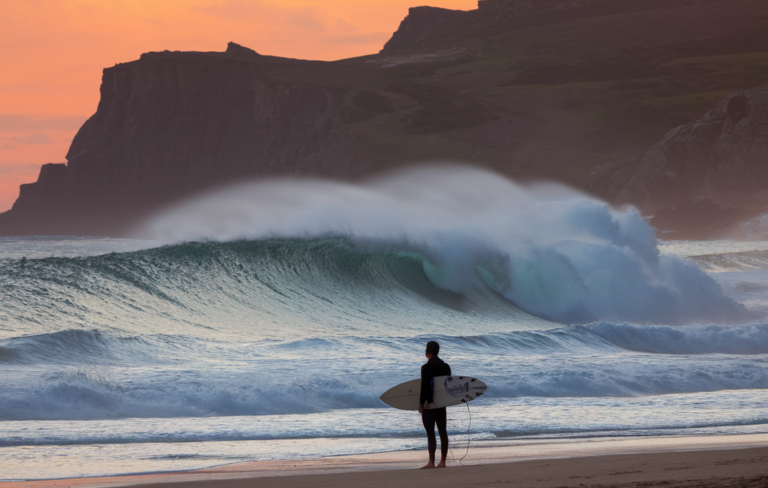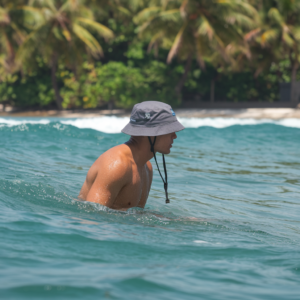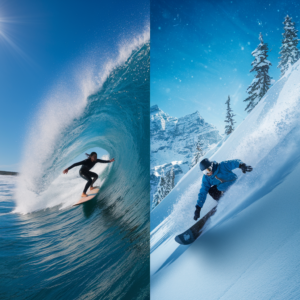Surfing takes place in the daylight hours and finding the best time to chase waves is a constant challenge. Often, surfers want to time their trip to the beach with the arrival of the best waves of the day.
That being said, busy surfers are always trying to fit a surf session around life’s obligations and can’t always be picky about chasing optimal conditions.
I often get asked, “What is the Best Time of Day to go Surfing?”
Most surfers will tell you that the general rule of thumb for the best time of day to go surfing is at sunrise and sunset. This is because dawn and dusk are generally the times of day with the calmest localized winds, which makes for clean, well formed waves.
Surfing is fun at any time so don’t worry if you always surf in the middle of the day! But keep in mind that there are some real benefits to going surfing when the day is beginning or ending.
Read on for the top reasons why the Best Time of Day to Surf is around Sunrise and Sunset!
5 Reasons Why Surfing is Best at Sunrise & Sunset?
One of the best things about surfing is that the ocean or “playing field” is available anytime between dawn and dusk.
There are many benefits that I have found by surfing at the start and end of the day and I want to highlight the top reasons for going surfing during sunrise or sunset.
1. Less Wind at Dawn & Dusk
Optimal surfing conditions usually occur when there are light offshore winds or no wind at all, which is usually at the start and end of the day.
In coastal areas, the wind is generally less prevalent when the temperature of the land is the same as the temperature of the ocean. This happens at dawn and dusk.
“The localized wind is created by the temperature differences between the land and the ocean.”
It is important to highlight that land absorbs solar radiation faster than the ocean.
A quick summary of what is happening with the wind:
- In the morning, the land and the ocean have similar surface temperatures so the sea breeze is light or non-existent.
- As the land begins to heat up during the day, the cold air above the ocean moves to the warmer zone above the land creating onshore winds and choppy conditions, which is bad for waves!
- In the evening, the surface temperature of the land begins to cool and the sea breeze dies off.
Surfing at sunrise and sunset will help you avoid the windy conditions that often occurs in the middle of the day. Onshore winds will push waves from behind and force them to break before they get steep.
“Avoid the midday wind and go early or go late and hopefully you will experience calm winds.”
2. Smaller Crowds in the Morning and Evening
Surfers use the term “Dawn Patrol” to describe the group of people that get up early to go surfing before the beach gets crowded.
This usually involves getting up, driving to the beach and suiting up in the dark in an effort to paddle out at first light. The sole purpose of dawn patrol is to start your day early and catch some uncrowded waves.
For most people, it is difficult to get up early and leave a warm, cozy bed to put on a cold, damp wetsuit and paddle into the ocean before the sun has risen, which is exactly what the dawn patrollers are counting on!
The same thing can be said for surfing around sunset. The end of the day comes with obligations like making dinner, picking up family members, doing homework and getting kids to bed.
Most surf breaks are less crowded at sunset because beach goers are packing up and heading home. Showing up to the beach at the end of the day is a great way to go surfing at a time when the crowds in the water are shrinking.
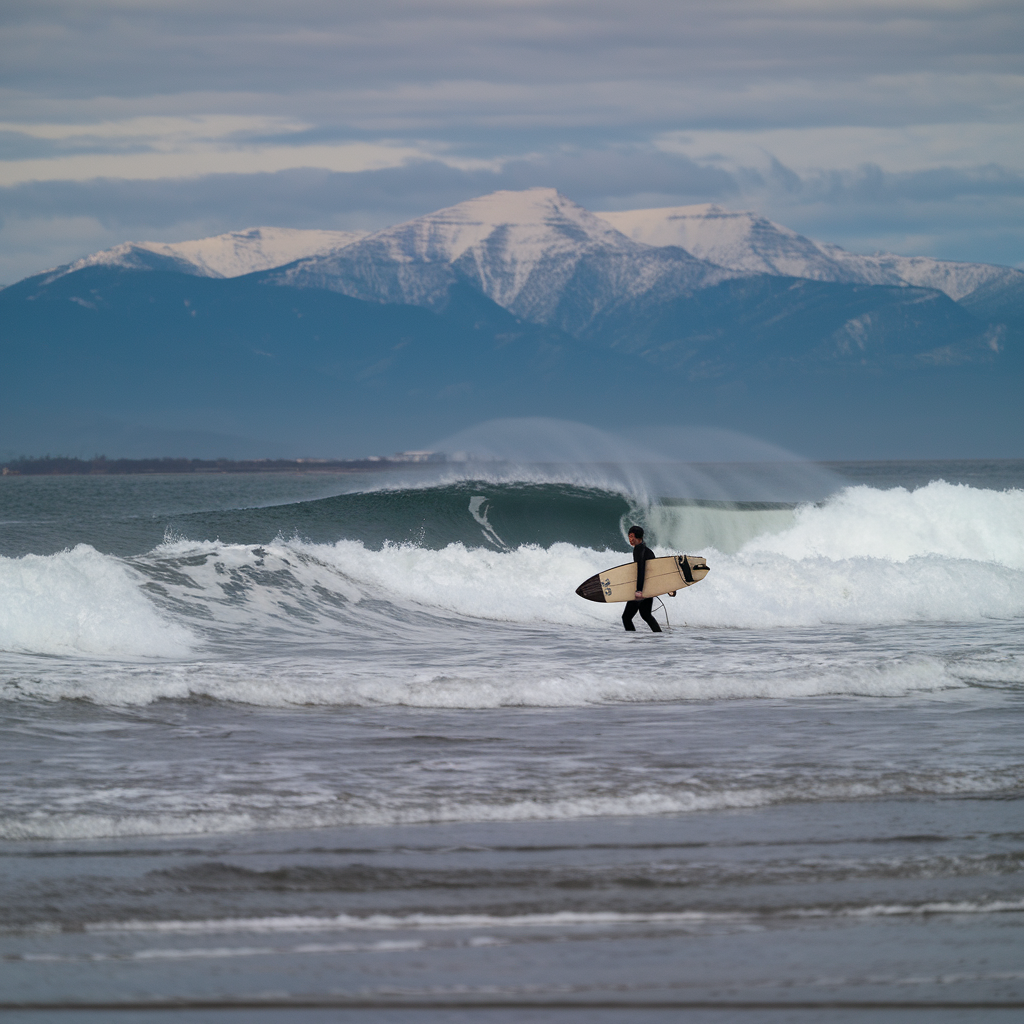
3. Sun’s Rays Are Less Harmful
According to the American Cancer Society,
“the damaging ultraviolet rays of the sun are strongest between 10:00am-4:00pm.”
For people that regularly engage in physical activity on a bright, sunny day there is a higher risk of overheating, sunstroke and sunburn.
Going surfing at sunrise or sunset is a great way to avoid the full strength of the sun’s rays. When the sun is rising and setting, the rays are passing through a greater distance of the earth’s atmosphere compared to when the sun is directly overhead.
Because of a lifetime of sun exposure, surfers have a higher risk of skin cancer than the general population. A recent study concluded that surfers should engage in a variety of sun protection activities to reduce their overall exposure.
Check out this graphs that show you the risks of cancer and their locations.

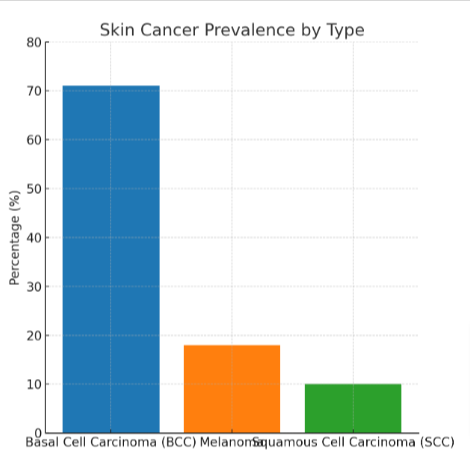
“Surfing when the sun’s rays are at its weakest, which is near the start and end of the day, is a great way to reduce your sun exposure.”
4. Increased Health Benefits
According to Healthline.com, working out in the morning results in a number of health benefits including better focus, alertness and an increase in overall energy level throughout the day.
In addition, working out regularly at the start of the day helps support weight loss and appetite control, which may lead to making better food choices.
It may be a Zen moment but surfers often talk about the calmness that they feel when they paddle into the ocean at sunrise and sunset. Going surfing as the sun is rising or setting is a great way to relax and reduce stress.
Sometimes it isn’t even about catching waves but more about sitting on your board and sharing a smile or laugh with other surfers. It is amazing how quickly you will forget about your problems when you are focused on catching waves.
Just yesterday, I went surfing around sunrise with some friends. The fun waves, constant chatter and relaxing atmosphere started the day with such a positive experience that I was grinning from ear to ear until bedtime.
5. Better Use of Time
It is a luxury to be able to go surfing at any time of day but most people have obligations like appointments, school or work that competes with their surfing habit. I prefer to go surfing early in the morning or at the end of the day because it is easier to fit it in around a busy schedule.
The best way to become a better surfer is to make a commitment to surf more, which requires flexibility and planning. Although waking up early or staying late isn’t the most popular time to go surfing, it pays off because it is often the best time to catch waves.
Put simply, going surfing at sunrise or sunset is a better use of your valuable time. The most time consuming aspect of surfing is traveling to and from the beach, which is why it should take place in the dark so you aren’t wasting precious daylight!
“Use the daylight for surfing and the darkness for everything else, like choosing which surfboard to ride, packing snacks and driving to the beach.”
Conclusion
Going surfing with the early crew or the late crew is a great way to score some of the best waves of the day. Often, you will experience less wind, smaller crowds and less stress at sunset and sunrise!
Go surfing, Have fun and Repeat!
For more interesting articles, read this:
Surfing vs Snowboarding: Which Is Harder?

